Seismic Resilience in Critical Infrastructures: A Power Station Preparedness Case Study
Abstract
1. Introduction
2. Background
2.1. Seismological Risks
2.2. Secondary Phenomena (Aftershocks and Beyond)
2.2.1. Soil Liquefaction
2.2.2. Slope Stability
2.2.3. Amplitudes of Seismic Waves
2.3. Tsunami
3. Methodology
3.1. Phase 1—Investigation of the Power Station
Power Station Location
- Primary Earthquake Event—it is crucial to identify the occurrence probabilities of earthquake events and their associated ground motion at the site. Hazard maps and other available data, such as historical seismic records or local geological surveys, can support this step. If required, probabilistic seismic hazard analysis (PSHA) models may be employed to quantify the likelihood of earthquakes impacting the power station, considering factors such as fault locations, seismic activity rates, and ground motion attenuation [46].
- Secondary Seismic Events—review of possible subsequent events that can be triggered as a result of the earthquake, such as:
- Amplification—evaluating the soil and geological conditions to determine the site’s susceptibility to seismic amplification.
- Slope Stability—assessing the probability of landslides and slope failure due to seismic shaking.
- Liquefaction—analyzing soil liquefaction potential based on soil composition, groundwater levels, and historical liquefaction occurrences.
- Tsunami—determination of the occurrence probability and characteristics of tsunami events, utilizing historical data, simulations, and other pertinent information.
- Power station structure and vulnerability.
3.2. Phase 2—Damage Assessment and Failure Analysis
- Subcomponent Damage Assessment—the predicted ground motion at the power station site is applied to the fragility curves in order to calculate the probability and severity of damage to each subcomponent.
- Cumulative Damage Evaluation—aggregation of damage accumulated from the primary and secondary events to assess the overall cumulative damage sustained by the subcomponents.
- Damage and Failure Analysis—a comprehensive failure analysis is conducted, considering the interdependencies between components and the system’s redundancy and resilience. Fault Tree Analysis (FTA) is utilized to provide an in-depth evaluation of failure modes and their implications.
3.3. Phase 3—Alternative Mitigation Strategies Evaluation
- Mitigation alternatives identification—possible mitigation strategies are identified to enhance the power station’s seismic resilience. These strategies could involve structural upgrades, system redundancies, improved emergency response plans, or other relevant measures.
- Updating the components’ vulnerability and system layout—based on the mitigation strategy and measures, the vulnerability of each component and the overall system layout are re-evaluated to reflect the expected impact on seismic resilience. This step includes updating fragility parameters, adjusting the system’s mechanical and functional relationships, and implementing other relevant modifications to its layout.
- Benefit-to-cost analysis—this process assesses the economic effectiveness of the proposed mitigation strategies by examining the balance between expected risk reduction and the costs of implementation. The analysis aims to evaluate each strategy’s worth and identify the most cost-effective option. This process compares the anticipated benefits of a mitigation measure, in terms of reduced economic losses from earthquakes, against the estimated costs of implementation. Decision trees are employed to systematically compare and quantify the benefits and costs of alternative strategies.
3.4. Phase 4—Synthesis and Recommendations
4. Case Study
4.1. Power Station Investigation
4.2. The Location and Seismic Risks
4.3. Power Station Structure and Vulnerability
4.3.1. Water Treatment Facility
4.3.2. Gas Pressure Regulating and Metering Station (PRMS)
4.3.3. Gas-Insulated Switchgear (GIS)
4.3.4. Oil and Water Tanks
4.3.5. Steam Boilers
4.3.6. Gas Turbines and Steam Turbines
4.4. Damage Assessment and Failure Analysis
4.5. Development and Evaluation of Alternative Mitigation Strategies
4.6. Case Study Summary
4.7. Guidelines and Recommendations
- Seismic risk assessment:
- Conduct detailed seismic risk assessments using updated geological data and advanced modeling techniques to identify potential seismic hazards specific to the location of the power station. This assessment includes evaluating fault lines, soil composition, and historical earthquake data.
- Design recommendations:
- Design critical components with enhanced seismic standards that exceed the minimum code requirements to ensure robustness against higher magnitude earthquakes.
- Anchoring and retrofitting:
- Implement anchoring solutions for all critical machinery and equipment to withstand the region’s anticipated seismic forces.
- Use high-quality, durable materials for anchoring to improve longevity and effectiveness.
- For existing structures, conduct thorough inspections to identify vulnerabilities and retrofit them with modern anchoring techniques to improve their seismic resilience.
- Isolation systems:
- Employ advanced base isolation systems and vibration control technologies to decouple the structure from the ground motion, significantly reducing the impact of seismic waves.
- Monitoring and maintenance:
- Install state-of-the-art seismic monitoring systems to provide real-time data on structural integrity during and after earthquakes.
- Routine maintenance schedules to inspect and maintain seismic mitigation equipment, ensuring all components function correctly and adhere to safety standards.
- Emergency response planning:
- Develop comprehensive emergency response plans that include evacuation routes, communication protocols, and recovery strategies to minimize downtime and ensure safety.
- Train staff regularly on these plans to ensure everyone knows their role during and after an earthquake.
- Collaboration with Experts:
- Engage with seismic experts, structural engineers, and researchers to stay updated on the latest advances in earthquake engineering and integrate these innovations into the design and maintenance of power stations.
- Regulatory compliance:
- Ensure all designs and modifications meet or exceed local and international building codes and standards related to seismic safety.
- Work with regulatory bodies to update and improve seismic standards based on the latest research and post-earthquake assessments.
5. Discussion
- The case study focuses on a gas power station located in Israel. Given the unique seismic and geotechnical characteristics of the region, the findings may not be directly applicable to other geographical locations. Therefore, future studies should consider a diverse set of geographical locations, including those with different seismic profiles and infrastructure types. Comparative studies across various regions could help generalize the findings and develop more universally applicable resilience strategies.
- The study does not account for the impact of aftershocks, which can lead to cumulative damage and affect the resilience and recovery of infrastructure following the primary earthquake event [69]. Future research could enrich the methodology with the analysis of aftershocks in seismic risk assessments.
- This research did not account for additional factors affecting seismic vulnerability, such as proper maintenance, the age of the facility, and the surrounding environment. Future research should integrate a broader set of parameters into the seismic risk assessment methodology as was presented by [70]. Adopting such an expanded approach will enhance the comprehensiveness and accuracy of evaluations, leading to more effective mitigation and preparedness strategies.
6. Conclusions
- The study utilized fragility curves and FTA to evaluate the seismic vulnerabilities across the power station’s components, demonstrating varying levels of risk with an average damage probability of 0.098 and a standard deviation of 0.0753.
- Anchoring subcomponents significantly reduced the overall damage probability from 57.32% to 27.33%, highlighting the effectiveness of retrofitting strategies in mitigating seismic risks.
- Despite the risk of soil liquefaction for foundations shallower than 20 m, the power station’s construction followed Israeli codes, incorporating foundations deeper than 20 m to reduce associated seismic-induced liquefication risks effectively.
- The construction of a tsunami protection wall, costing less than 0.5% of the total construction budget, demonstrates a cost-effective investment in protecting against tsunami impacts, enhancing the station’s resilience without significant financial burden.
- The mitigation strategies employed, including the tsunami protection wall and the anchoring of subcomponents, ensure the operational continuity and safety of the power station in the face of natural disasters, underscoring the importance of proactive planning and implementation in critical infrastructure projects.
Author Contributions
Funding
Institutional Review Board Statement
Informed Consent Statement
Data Availability Statement
Conflicts of Interest
References
- Observatory Cumbria Intelligence. Cumbria Floods November 2009: An Impact Assessment; Cumbria Intelligence Observatory Carlisle: Carlisle, UK, 2010. [Google Scholar]
- Urlainis, A.; Ornai, D.; Levy, R.; Vilnay, O.; Shohet, I.M. Loss and Damage Assessment in Critical Infrastructures Due to Extreme Events. Saf. Sci. 2022, 147, 105587. [Google Scholar] [CrossRef]
- Cinar, E.N.; Abbara, A.; Yilmaz, E. Earthquakes in Turkey and Syria-Collaboration Is Needed to Mitigate Longer Terms Risks to Health. BMJ 2023, 380, 559. [Google Scholar] [CrossRef] [PubMed]
- Forzieri, G.; Bianchi, A.; Silva, F.B.E.; Marin Herrera, M.A.; Leblois, A.; Lavalle, C.; Aerts, J.C.J.H.; Feyen, L. Escalating Impacts of Climate Extremes on Critical Infrastructures in Europe. Glob. Environ. Chang. 2018, 48, 97–107. [Google Scholar] [CrossRef] [PubMed]
- Krausmann, E.; Cruz, A.M. Impact of the 11 March 2011, Great East Japan Earthquake and Tsunami on the Chemical Industry. Nat. Hazards 2013, 67, 811–828. [Google Scholar] [CrossRef]
- Woods, D.D. Four Concepts for Resilience and the Implications for the Future of Resilience Engineering. Reliab. Eng. Syst. Saf. 2015, 141, 5–9. [Google Scholar] [CrossRef]
- Bruno, M.; Clegg, R. A Foresight Review of Resilience Engineering. Lloyd’s Regist. Found. Rep. Ser. 2015. [Google Scholar] [CrossRef]
- Rus, K.; Kilar, V.; Koren, D. Resilience Assessment of Complex Urban Systems to Natural Disasters: A New Literature Review. Int. J. Disaster Risk Reduct. 2018, 31, 311–330. [Google Scholar] [CrossRef]
- The Rockefeller Foundation, City Resilience Framework. Rockefeller Found. ARUP 2014, 928.
- Yang, Z.; Barroca, B.; Weppe, A.; Bony-Dandrieux, A.; Laffréchine, K.; Daclin, N.; November, V.; Omrane, K.; Kamissoko, D.; Benaben, F.; et al. Indicator-Based Resilience Assessment for Critical Infrastructures—A Review. Saf. Sci. 2023, 160, 106049. [Google Scholar] [CrossRef]
- Urlainis, A.; Shohet, I.M. Seismic Risk Mitigation and Management for Critical Infrastructures Using an RMIR Indicator. Buildings 2022, 12, 1748. [Google Scholar] [CrossRef]
- Fei, Z.; Guo, X.; Odongo, J.O.; Ma, D.; Ren, Y.; Wu, J.; Wang, W.; Zhu, J. A Seismic Fragility Assessment Method for Urban Function Spatial Units: A Case Study of Xuzhou City. Sustainability 2023, 15, 8022. [Google Scholar] [CrossRef]
- Mogheisi, M.; Tavakoli, H.; Peyghaleh, E. Probability Assessment of the Seismic Risk of Highway Bridges with Various Structural Systems (Case Study: Tehran City). Sustainability 2023, 15, 9783. [Google Scholar] [CrossRef]
- Rota, M.; Zito, M.; Dubini, P.; Nascimbene, R. On the Use of Accelerometric Data to Monitor the Seismic Performance of Non-Structural Elements in Existing Buildings: A Case Study. Buildings 2023, 13, 2651. [Google Scholar] [CrossRef]
- Maidi, M.; Lifshitz Sherzer, G.; Gal, E. Enhancing Ductility in Carbon Fiber Reinforced Polymer Concrete Sections: A Multi-Scale Investigation. Comput. Concr. 2024, 33, 385–398. [Google Scholar] [CrossRef]
- Shafieezadeh, A.; Burden, L.I. Scenario-Based Resilience Assessment Framework for Critical Infrastructure Systems: Case Study for Seismic Resilience of Seaports. Reliab. Eng. Syst. Saf. 2014, 132, 207–219. [Google Scholar] [CrossRef]
- Espinoza, S.; Poulos, A.; Rudnick, H.; De La Llera, J.C.; Panteli, M.; Mancarella, P. Risk and Resilience Assessment with Component Criticality Ranking of Electric Power Systems Subject to Earthquakes. IEEE Syst. J. 2020, 14, 2837–2848. [Google Scholar] [CrossRef]
- Messore, M.M.; Capacci, L.; Biondini, F. Life-Cycle Cost-Based Risk Assessment of Aging Bridge Networks. Struct. Infrastruct. Eng. 2020, 17, 515–533. [Google Scholar] [CrossRef]
- Forcellini, D. A Novel Methodology to Assess Seismic Resilience (SR) of Interconnected Infrastructures. Appl. Sci. 2022, 12, 12975. [Google Scholar] [CrossRef]
- Rezvani, S.M.H.S.; Falcão Silva, M.J.; de Almeida, N.M. The Risk-Informed Asset-Centric (RIACT) Urban Resilience Enhancement Process: An Outline and Pilot-Case Demonstrator for Earthquake Risk Mitigation in Portuguese Municipalities. Appl. Sci. 2024, 14, 634. [Google Scholar] [CrossRef]
- Garfunkel, Z.; Zak, I.; Freund, R. Active Faulting in the Dead Sea Rift. Tectonophysics 1981, 80, 1–26. [Google Scholar] [CrossRef]
- Baker, J.; Bradley, B.; Stafford, P. Seismic Hazard and Risk Analysis; Cambridge University Press: Cambridge, UK, 2021; ISBN 1108604900. [Google Scholar]
- Israel Standard-413-3; Designing Structural Resistance to Earthquakes. 413 Part 3. Israel Standards Institution: Tel Aviv, Israel, 1998. (In Hebrew)
- Israel Standard-413-5; Designing Structural Resistance to Earthquakes. 413 Part 5. Israel Standards Institution: Tel Aviv, Israel, 1998. (In Hebrew)
- Bayati, H.; Bagheripour, M.H. Shaking Table Study on Liquefaction Behaviour of Different Saturated Sands Reinforced by Stone Columns. Mar. Georesources Geotechnol. 2019, 37, 801–815. [Google Scholar] [CrossRef]
- Ko, Y.Y.; Chen, C.H. On the Variation of Mechanical Properties of Saturated Sand during Liquefaction Observed in Shaking Table Tests. Soil Dyn. Earthq. Eng. 2020, 129, 105946. [Google Scholar] [CrossRef]
- Friedman, S.; Salamon, A.; Zveibil, D.; Beton, R.; Katz, O. Assessment of Liquefaction Potential in the Zevulun Valley: A Geotechnical Perspective; Report GSI/09/2007; Geological Survey of Israel: Jerusalem, Israel, 2007.
- Davies, T.C. Landslide Research in Kenya. J. African Earth Sci. 1996, 23, 541–545. [Google Scholar] [CrossRef]
- Ngecu, W.M.; Ichang’i, D.W. The Environmental Impact of Landslides on the Population Living on the Eastern Footslopes of the Aberdare Ranges in Kenya: A Case Study of Maringa Village Landslide. Environ. Geol. 1999, 38, 259–264. [Google Scholar] [CrossRef]
- Claessens, L.; Knapen, A.; Kitutu, M.G.; Poesen, J.; Deckers, J.A. Modelling Landslide Hazard, Soil Redistribution and Sediment Yield of Landslides on the Ugandan Footslopes of Mount Elgon. Geomorphology 2007, 90, 23–35. [Google Scholar] [CrossRef]
- Knapen, A.; Kitutu, M.G.; Poesen, J.; Breugelmans, W.; Deckers, J.; Muwanga, A. Landslides in a Densely Populated County at the Footslopes of Mount Elgon (Uganda): Characteristics and Causal Factors. Geomorphology 2006, 73, 149–165. [Google Scholar] [CrossRef]
- Maina-Gichaba, C.; Kipseba, E.K.; Masibo, M. Overview of Landslide Occurrences in Kenya: Causes, Mitigation, and Challenges. In Developments in Earth Surface Processes; Elsevier: Amsterdam, The Netherlands, 2013; Volume 16, pp. 293–314. ISBN 0928-2025. [Google Scholar]
- Katz, A.; Almog, A. Landslide Risk Assessment Map for Northern Israel: A Comprehensive Overview at a 1:200,000 Scale; GSI/38/2006; Geological Survey of Israel: Jerusalem, Israel, 2006.
- Mitelman, A.; Lifshitz Sherzer, G. Coupling Numerical Modeling and Machine-Learning for Back Analysis of Cantilever Retaining Wall Failure. Comput. Concr. 2023, 31, 307. [Google Scholar] [CrossRef]
- Lifshitz Sherzer, G.; Grigorovitch, M.; Mitelman, A. Insights from LDPM Analysis on Retaining Wall Failure. Comput. Concr. 2024, 33. [Google Scholar]
- Wang, S.; Hao, H. Effects of Random Variations of Soil Properties on Site Amplification of Seismic Ground Motions. Soil Dyn. Earthq. Eng. 2002, 22, 551–564. [Google Scholar] [CrossRef]
- Wang, L.; Wu, Z.; Xia, K. Effects of Site Conditions on Earthquake Ground Motion and Their Applications in Seismic Design in Loess Region. J. Mt. Sci. 2017, 14, 1185–1193. [Google Scholar] [CrossRef]
- Frid, M.; Kamai, R. Characterizing Nonlinear Effects in Vertical Site Response of Dry Soils Using KiK-Net Data. J. Earthq. Eng. 2023, 27, 2570–2586. [Google Scholar] [CrossRef]
- Kamai, R.; Yagoda-Biran, G. Engineering-Oriented Ground-Motion Model for Israel. Bull. Earthq. Eng. 2023, 21, 3199–3220. [Google Scholar] [CrossRef]
- Ewing, L. A Preliminary Report on Effects to the California Coast and Planning Implications; A Report to Coastal Commissioners; National Centers for Environmental Information (NCEI): Asheville, NC, USA, 2011.
- NOAA On This Day: Great Alaska Earthquake and Tsunami. 2017. Available online: https://www.ncei.noaa.gov/news/great-alaska-earthquake (accessed on 10 April 2024).
- FEMA Hazus Earthquake Model Technical Manual; Federal Emergency Management Agency: Washington, DC, USA, 2020; pp. 1–436.
- ASCE/SEI 31-03; ASCE Seismic Evaluation of Existing Buildings. American Society of Civil Engineers: Reston, VA, USA, 2003.
- ASCE/SEI 7-10; ASCE Minimum Design Loads for Buildings and Other Structures. American Society of Civil Engineers: Reston, VA, USA, 2010.
- ASCE Tohoku Japan Tsunami of 11 March 2011–Performance of Structures; ASCE Monograph, American Society of Civil Engineers: Reston, VA, USA, 2012.
- Baker, J.W. An Introduction to Probabilistic Seismic Hazard Analysis (PSHA). Bak. Res. Gr. 2008, 1–72. [Google Scholar]
- FEMA Hazus Earthquake Model Technical Manual—Hazus 5.1; Federal Emergency Management Agency: Washington, DC, USA, 2022; Volume 1, pp. 1–467.
- Hamburger, R.O. FEMA P58 Seismic Performance Assessment of Buildings. In Proceedings of the NCEE 2014—10th U.S. National Conference on Earthquake Engineering: Frontiers of Earthquake Engineering, Anchorage, AK, USA, 21–25 July 2014. [Google Scholar]
- Alliance American Lifelines (ALA). Seismic Fragility Formulations for Water Systems. 2001. Available online: https://www.americanlifelinesalliance.com/pdf/Part_1_Guideline.pdf (accessed on 10 April 2024).
- Gehl, P.; Desramaut, N.; Réveillère, A.; Modaressi, H. Fragility Functions of Gas and Oil Networks. Geotech. Geol. Earthq. Eng. 2014, 27, 187–220. [Google Scholar]
- O’Rourke, M.J.; So, P. Seismic Fragility Curves for On-Grade Steel Tanks. Earthq. Spectra 2000, 16, 801–815. [Google Scholar] [CrossRef]
- Baker, J.W. Efficient Analytical Fragility Function Fitting Using Dynamic Structural Analysis. Earthq. Spectra 2015, 31, 579–599. [Google Scholar] [CrossRef]
- Rabi, R.R.; Bianco, V.; Monti, G. Mechanical-Analytical Soil-Dependent Fragility Curves of Existing Rc Frames with Column-Driven Failures. Buildings 2021, 11, 278. [Google Scholar] [CrossRef]
- Dabiri, H.; Faramarzi, A.; Dall’Asta, A.; Tondi, E.; Micozzi, F. A Machine Learning-Based Analysis for Predicting Fragility Curve Parameters of Buildings. J. Build. Eng. 2022, 62, 105367. [Google Scholar] [CrossRef]
- Urlainis, A.; Shohet, I.M. Development of Exclusive Seismic Fragility Curves for Critical Infrastructure: An Oil Pumping Station Case Study. Buildings 2022, 12, 842. [Google Scholar] [CrossRef]
- Klar, A.; Meirova, T.; Zaslavsky, Y.; Shapira, A. Spectral Acceleration Maps for Use in SI 413 Amendment No. 5. Geophys. Inst. Isr. Jerus. Isr. 2011. [Google Scholar]
- Salamon, A.; Netzer-Cohen, C.; Zilberman, E.; Amit, R. Qualitative Evaluation of Earthquake Hazards for Archaeological and Historical Sites in Israel; Technical Report GSI/28/2014; 2014. [Google Scholar]
- Salamon, A.; Netzer-Cohen, C.; Cohen, M.; Zilberman, E. Preliminary Methodology for Qualitative Assessment of Earthquake Hazards to Historical Monuments in Israel. Int. J. Disaster Risk Reduct. 2018, 31, 1062–1081. [Google Scholar] [CrossRef]
- Katz, O.; Hecht, H.; Almog, E. National Hazard Map of Slope-Failure in Israel. GSI/07/2008; 2008. [Google Scholar]
- Federal Emergency Management Agency (FEMA). Hazus Flood Model User Guidance; Federal Emergency Management Agency: Washington, DC, USA, 2018.
- GCR, N. Development of NIST Measurement Science R&D Roadmap: Earthquake Risk Reduction in Buildings; The National Institute of Building Sciences: Washington, DC, USA, 2013. [Google Scholar]
- Maffei, J.R. The Seismic Evaluation and Retrofitting of Bridges. Ph.D. Thesis, University of Canterbury, Christchurch, New Zealand, 1996. [Google Scholar] [CrossRef]
- Scholl, R.E. Reducing Seismic Hazards of Existing Buildings; DIANE Publishing: Collingdale, PA, USA, 1993; ISBN 1568065736. [Google Scholar]
- Dizhur, D.; Schultz, A.; Ingham, J. Pull-Out Behavior of Adhesive Connections in URM Walls. Earthq. Spectra 2016, 32, 2357–2375. [Google Scholar] [CrossRef]
- Zhang, K.; Fang, Z.; Nanni, A.; Hu, J.; Chen, G. Experimental Study of a Large-Scale Ground Anchor System with FRP Tendon and RPC Grout Medium. J. Compos. Constr. 2015, 19, 4014073. [Google Scholar] [CrossRef]
- Cerato, A.B.; Victor, R. Effects of Long-Term Dynamic Loading and Fluctuating Water Table on Helical Anchor Performance for Small Wind Tower Foundations. J. Perform. Constr. Facil. 2009, 23, 251–261. [Google Scholar] [CrossRef]
- Omidvar, B.; Azizi, R.; Abdollahi, Y. Seismic Risk Assessment of Power Substations. Environ. Energy Econ. Res. 2017, 1, 43–60. [Google Scholar]
- Pavel, F.; Vacareanu, R. Seismic Risk Assessment for Elements of the Electric Network in Romania. Buildings 2022, 12, 244. [Google Scholar] [CrossRef]
- Li, P.; Li, X.; Wang, X.; Wang, D. Seismic Resilience Evaluation of Reinforced Concrete Frame Considering the Effect of Mainshock-Aftershock Sequences. Appl. Sci. 2023, 13, 12620. [Google Scholar] [CrossRef]
- Urlainis, A.; Shohet, I.M. A Comprehensive Approach to Earthquake-Resilient Infrastructure: Integrating Maintenance with Seismic Fragility Curves. Buildings 2023, 13, 2265. [Google Scholar] [CrossRef]
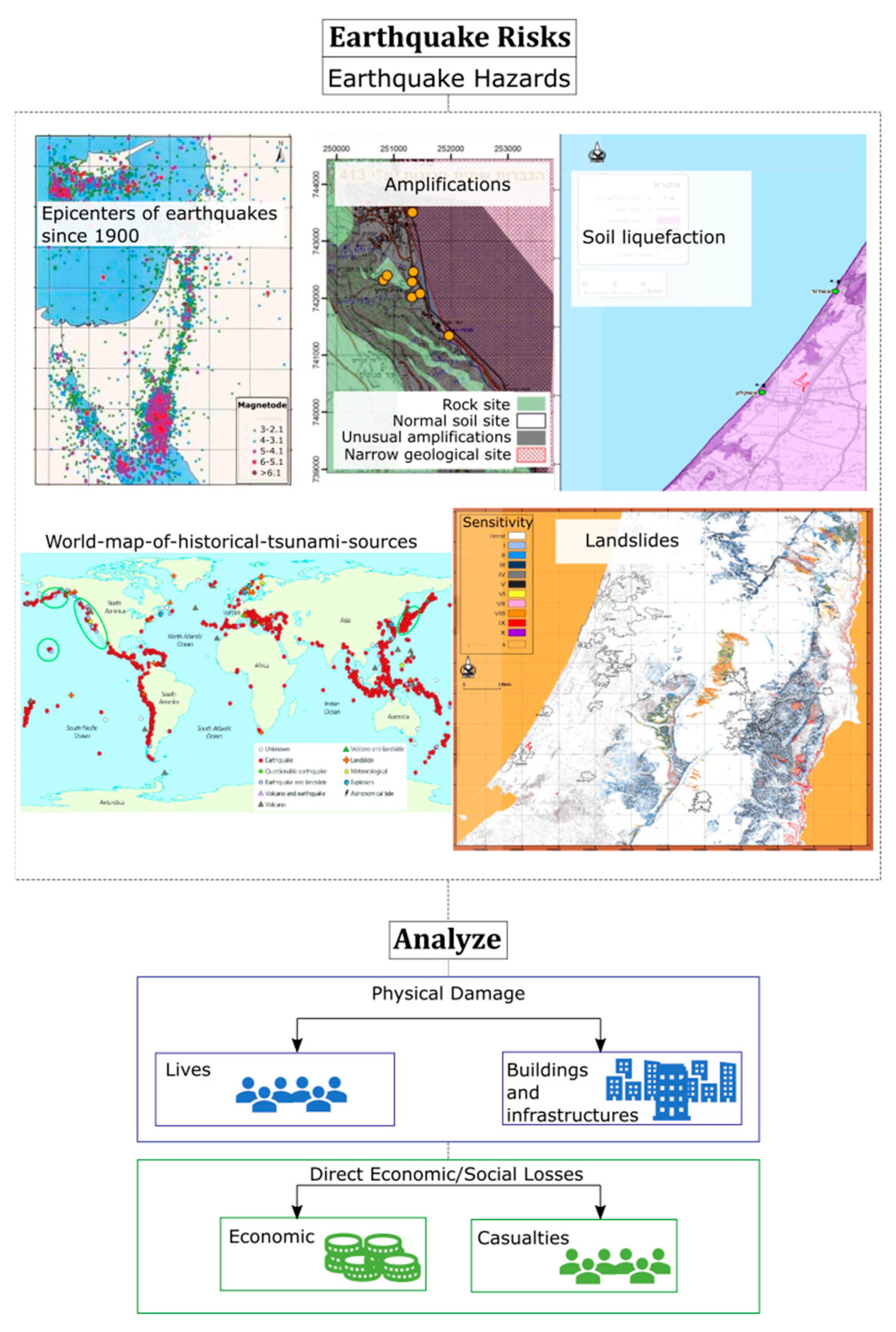
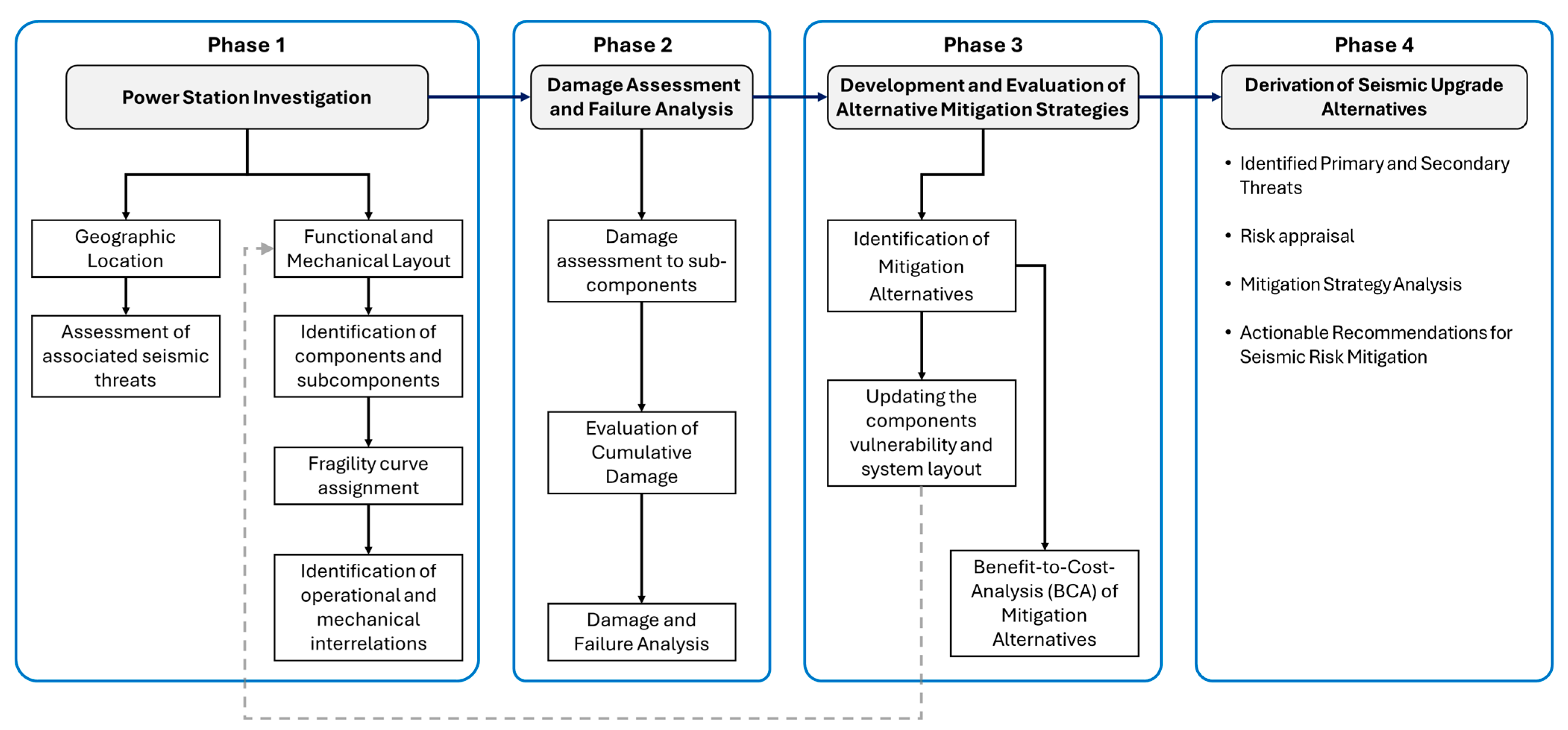
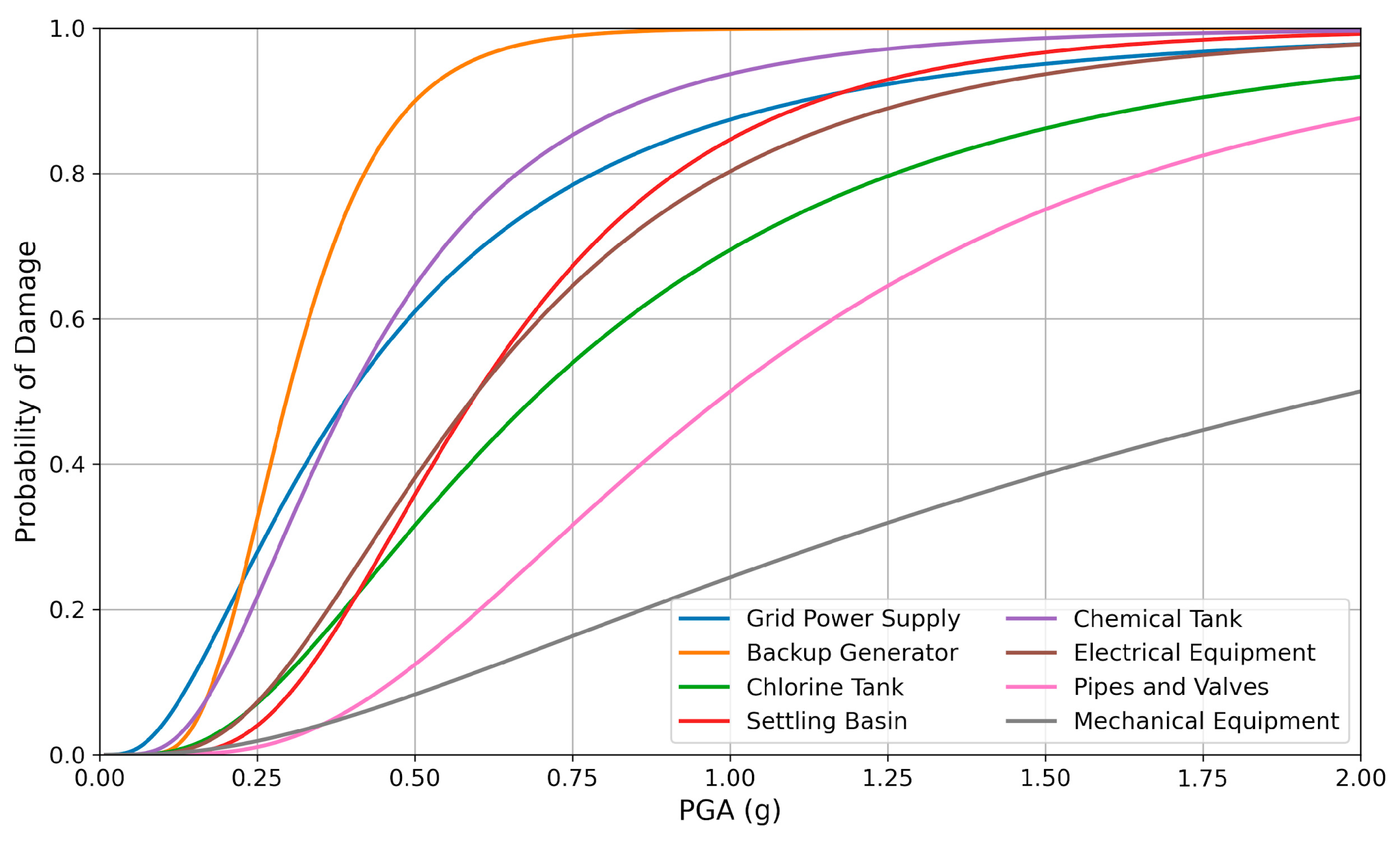
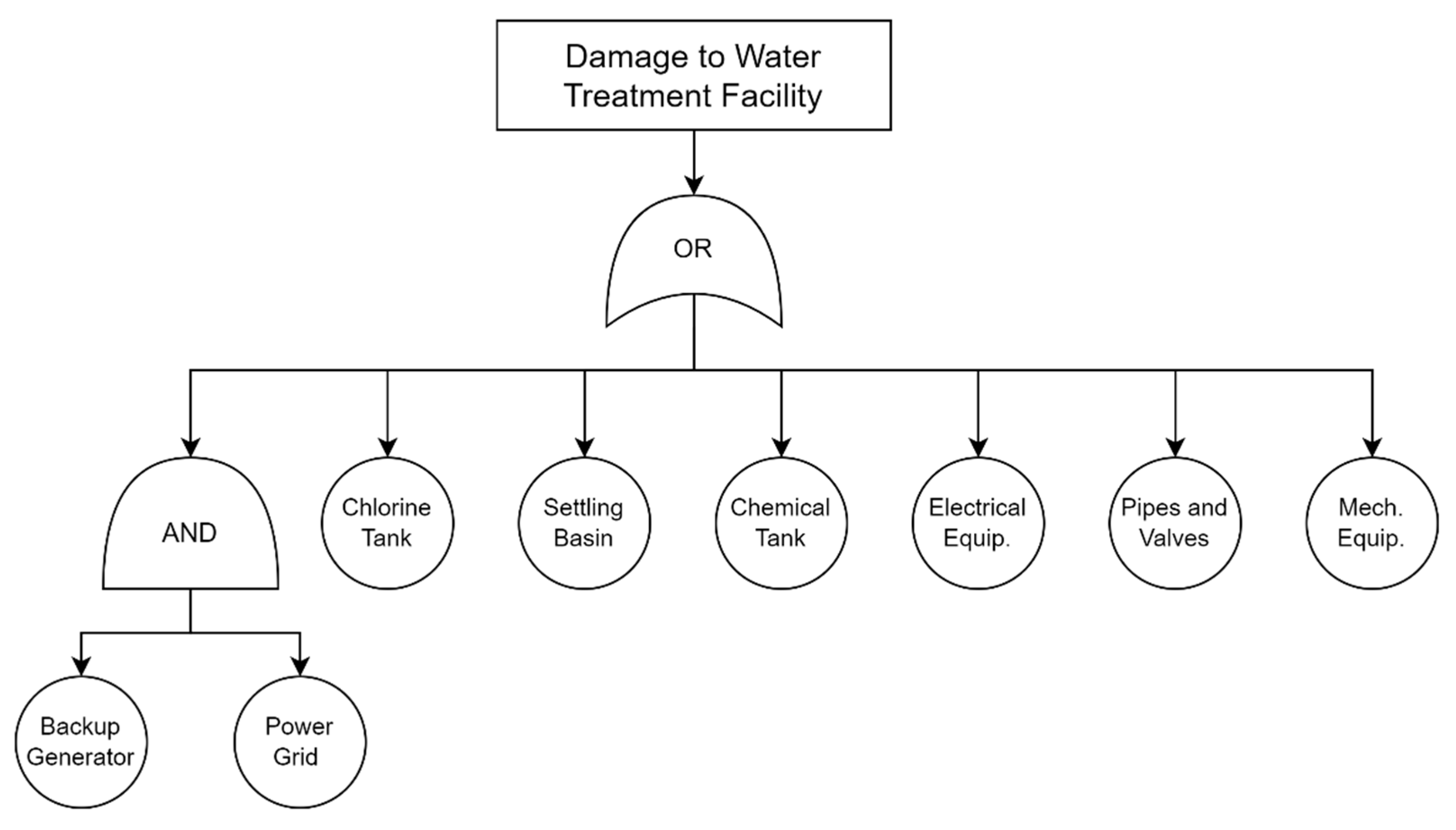
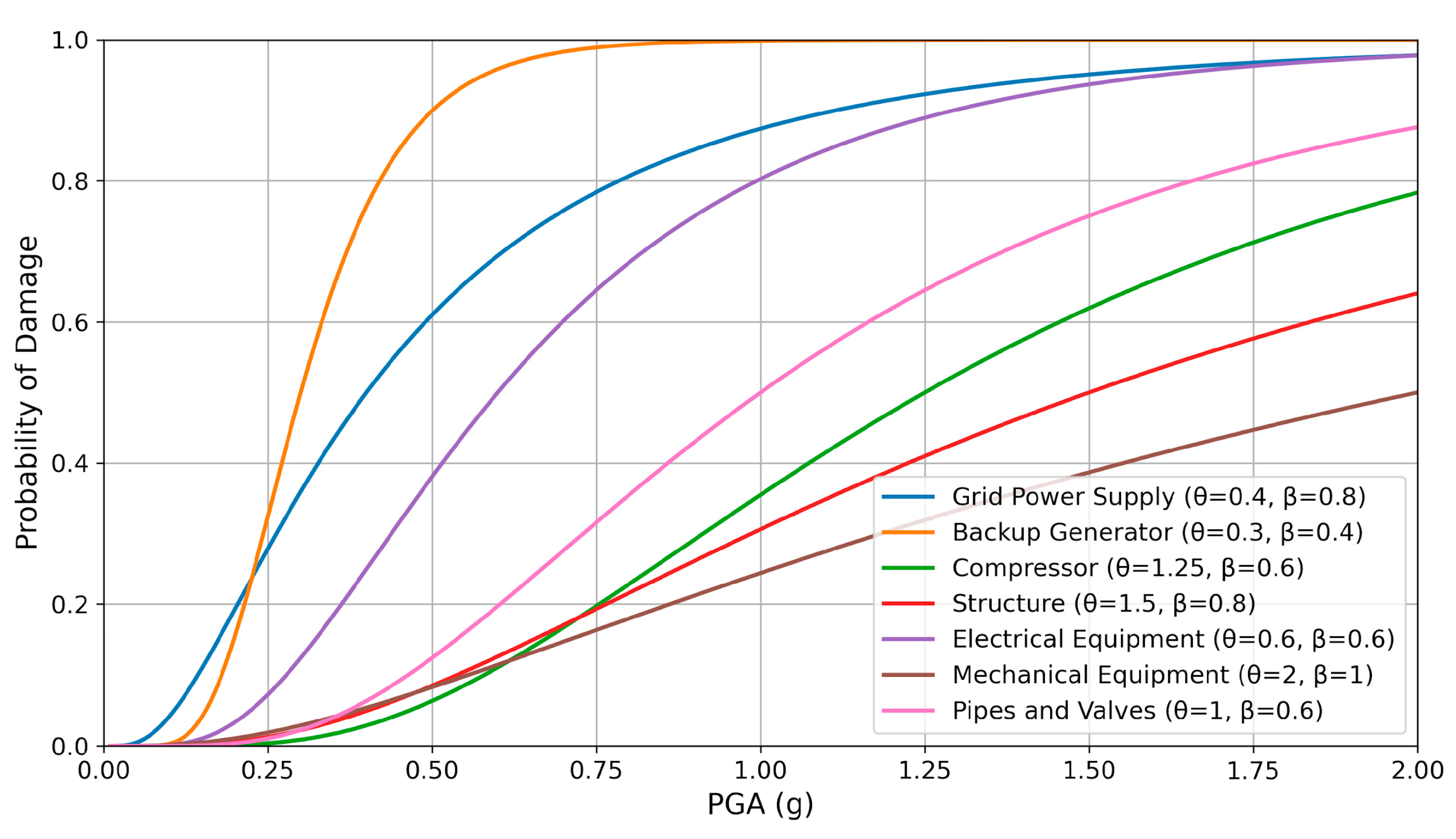
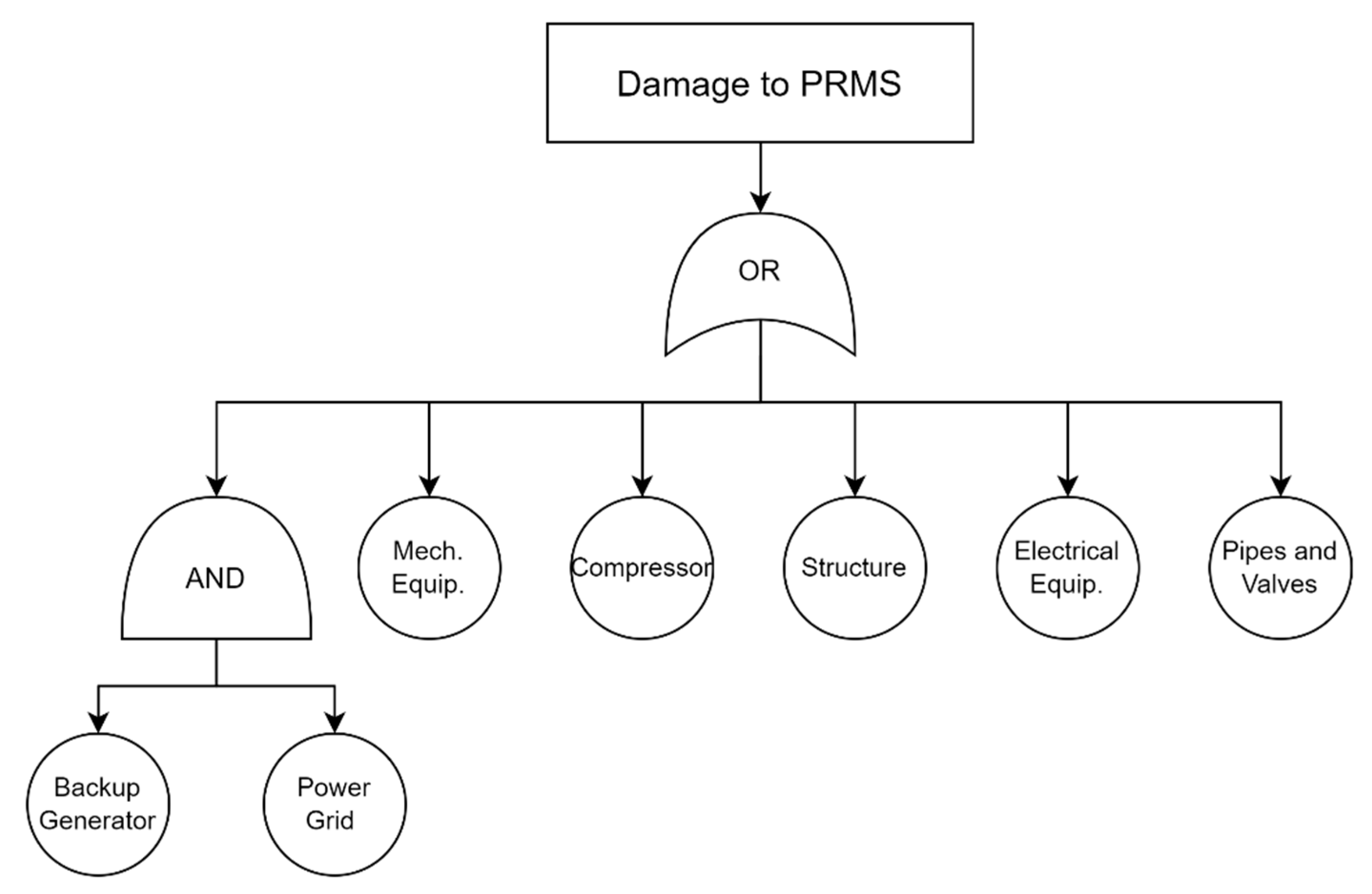
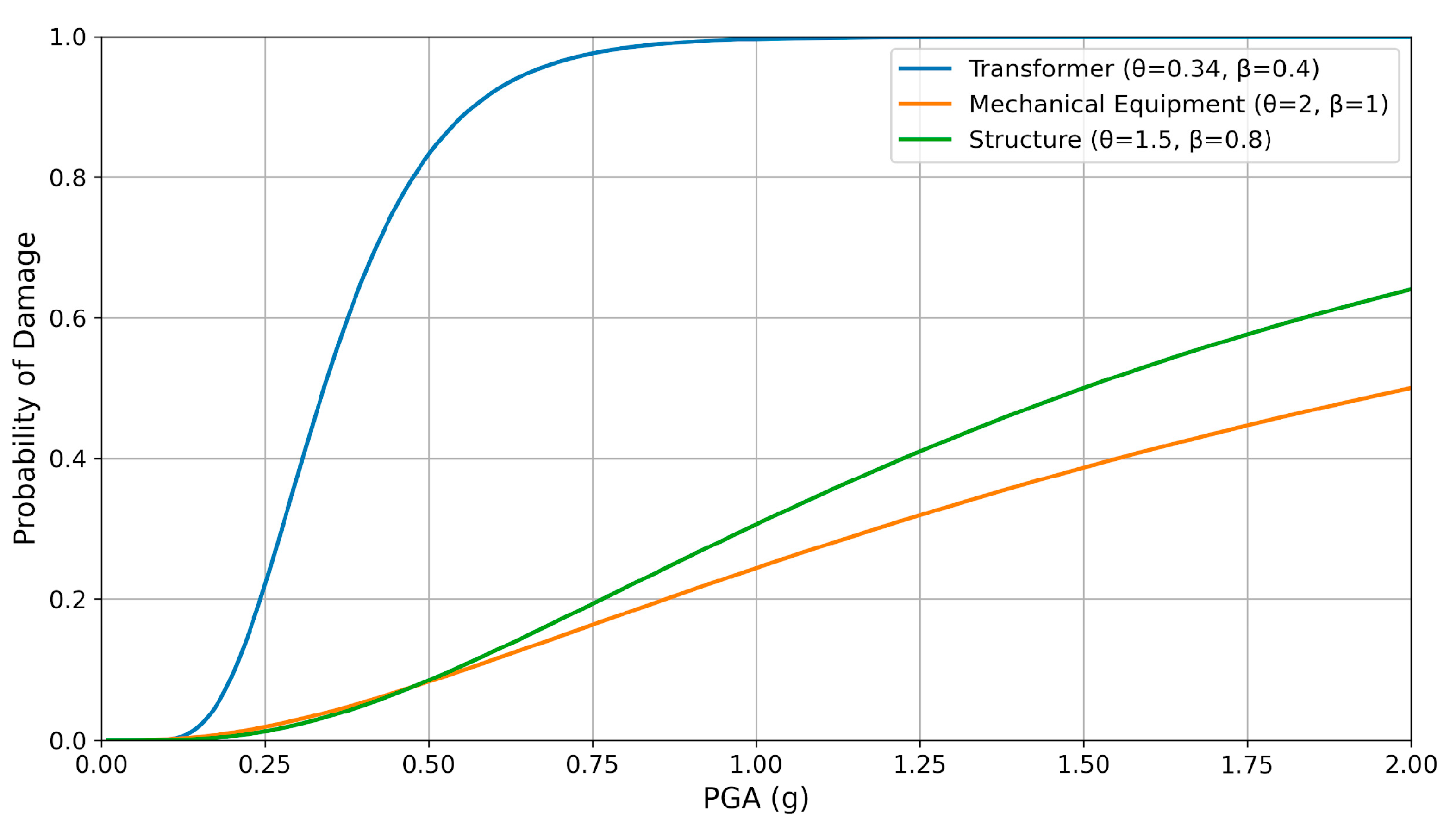


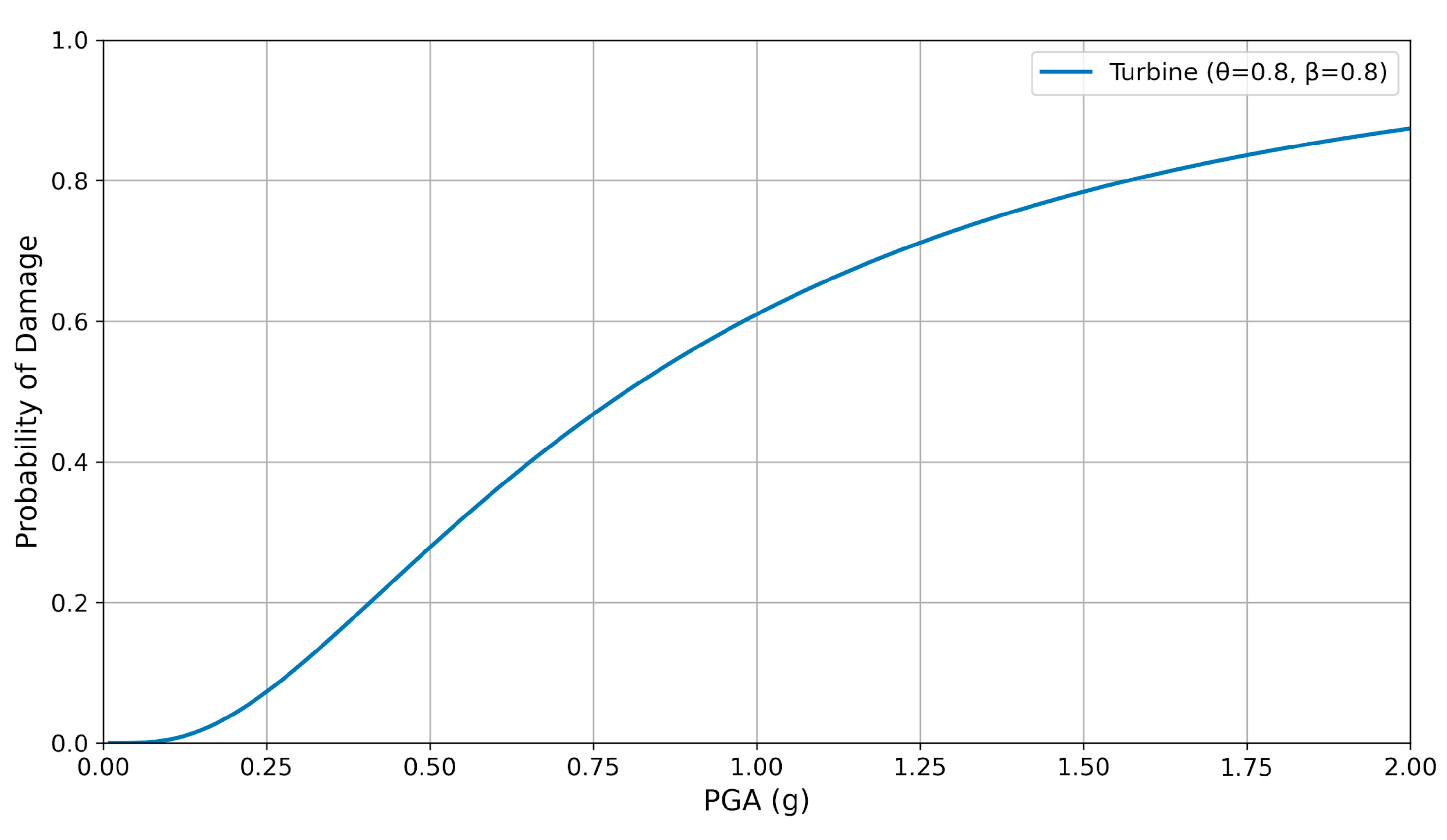
| Level of Hazard | Relative Degree of Hazard (HGS) | Criteria |
|---|---|---|
| Highest | 4 | PGA ≥ 0.2 g |
| High | 3 | 0.2 g > PGA ≥ 0.15 g |
| Moderate | 2 | 0.15 g > PGA≥ 0.1 g |
| Lowest | 1 | PGA < 0.1 g |
| Level of Hazard | Relative Degree of Hazard | Criteria |
|---|---|---|
| Highest | 4 | “Unconsolidated soil” + “PGA ≥ 0.15 g” + “shallow (<20 m) ground water”; reclaimed areas; coastal area within this PGA |
| High | 3 | “Unconsolidated soil” + “0.10 g ≤ PGA < 0.15 g” + “shallow (<20 m) ground water”; coastal area within this PGA |
| Moderate | 2 | “Unconsolidated soil” + “0.05 g ≤ PGA < 0.10 g” + “shallow (<20 m) ground water”; coastal area within this PGA |
| Lowest | 1 | coastal area within this PGA “Unconsolidated soil” + “PGA < 0.05 g” + “shallow (<20 m) ground water”; coastal area within this PGA |
| Subcomponent | Median (θ) | Std (β) | Damage Probability * |
|---|---|---|---|
| Grid Power Supply | 0.4 | 0.8 | 0.193 |
| Backup Generator | 0.3 | 0.4 | 0.155 |
| Chlorine Tank | 0.7 | 0.7 | 0.037 |
| Settling Basin | 0.6 | 0.5 | 0.014 |
| Chemical Tank | 0.4 | 0.6 | 0.124 |
| Electrical Equipment | 0.6 | 0.6 | 0.034 |
| Pipes and Valves | 1.0 | 0.6 | 0.004 |
| Mechanical Equipment | 2.0 | 1.0 | 0.011 |
| Subcomponent | Median (θ) | Std (β) | Damage Probability * |
|---|---|---|---|
| Power Supply Grid | 0.4 | 0.8 | 0.193 |
| Backup Generator | 0.3 | 0.4 | 0.155 |
| Compressor | 1.25 | 0.6 | 0.001 |
| Structure | 1.5 | 0.8 | 0.006 |
| Electrical Equipment | 0.6 | 0.6 | 0.034 |
| Mechanical Equipment | 2 | 1 | 0.011 |
| Pipes and Valves | 1 | 0.6 | 0.004 |
| Power Station Component | Damage Probability * |
|---|---|
| Gas Turbines | 7.68 × 10−5 |
| Steam Turbines | 0.0416 |
| Steam Boiler | 0.0109 |
| GIS (Gas-Insulated Switchgear) | 0.1020 |
| PRMS (Pressure Regulating and Metering Station) | 0.0824 |
| Water Treatment Facility | 0.2312 |
| Water storage Tank | 0.1570 |
| Oil storage Tank | 0.1570 |
| Power Station Component | Damage Probability | |
|---|---|---|
| Unanchored | Anchored | |
| Gas Turbines | 7.68 × 10−5 | 7.68 × 10−5 |
| Steam Turbines | 0.0416 | 0.0416 |
| Steam Boiler | 0.0109 | 0.0109 |
| GIS (Gas-Insulated Switchgear) | 0.1020 | 0.0360 |
| PRMS (Pressure Regulating and Metering Station) | 0.0824 | 0.0130 |
| Water Treatment Facility | 0.2312 | 0.0893 |
| Water storage Tank | 0.1570 | 0.0620 |
| Oil storage Tank | 0.1570 | 0.0620 |
| Average | 0.0978 | 0.0394 |
| Standard Deviation | 0.0753 | 0.0360 |
| Power Station Total Probability of Damage | 0.5732 | 0.2733 |
Disclaimer/Publisher’s Note: The statements, opinions and data contained in all publications are solely those of the individual author(s) and contributor(s) and not of MDPI and/or the editor(s). MDPI and/or the editor(s) disclaim responsibility for any injury to people or property resulting from any ideas, methods, instructions or products referred to in the content. |
© 2024 by the authors. Licensee MDPI, Basel, Switzerland. This article is an open access article distributed under the terms and conditions of the Creative Commons Attribution (CC BY) license (https://creativecommons.org/licenses/by/4.0/).
Share and Cite
Lifshitz Sherzer, G.; Urlainis, A.; Moyal, S.; Shohet, I.M. Seismic Resilience in Critical Infrastructures: A Power Station Preparedness Case Study. Appl. Sci. 2024, 14, 3835. https://doi.org/10.3390/app14093835
Lifshitz Sherzer G, Urlainis A, Moyal S, Shohet IM. Seismic Resilience in Critical Infrastructures: A Power Station Preparedness Case Study. Applied Sciences. 2024; 14(9):3835. https://doi.org/10.3390/app14093835
Chicago/Turabian StyleLifshitz Sherzer, Gili, Alon Urlainis, Shani Moyal, and Igal M. Shohet. 2024. "Seismic Resilience in Critical Infrastructures: A Power Station Preparedness Case Study" Applied Sciences 14, no. 9: 3835. https://doi.org/10.3390/app14093835
APA StyleLifshitz Sherzer, G., Urlainis, A., Moyal, S., & Shohet, I. M. (2024). Seismic Resilience in Critical Infrastructures: A Power Station Preparedness Case Study. Applied Sciences, 14(9), 3835. https://doi.org/10.3390/app14093835








